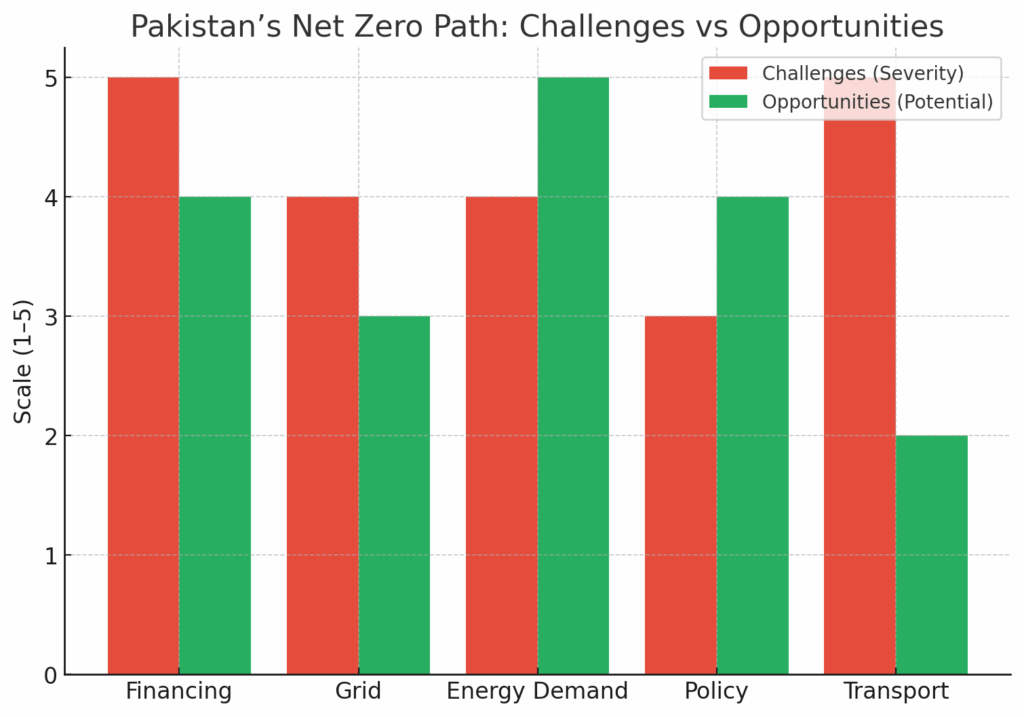Pakistan, one of the most climate-vulnerable countries in the world, has pledged to pursue a low-carbon development pathway and eventually achieve net zero emissions. The ambition is clear, but the road is complex and costly. As global attention shifts to climate resilience, the question remains: can Pakistan realistically meet the 2050 net zero target?
Current Energy & Emissions Landscape
Pakistan’s energy mix is gradually shifting, but fossil fuels still dominate. According to Ember Energy’s 2024 data, nearly 53% of electricity still comes from fossil fuels, while the share of low-carbon sources — hydropower, nuclear, wind, and solar — has reached 47%.
Hydropower contributes the largest portion of clean electricity, while nuclear plants are steadily growing in output. Wind and solar combined contribute around 13%, but recent expansion suggests momentum.
A report in The Nation (June 2025) revealed that renewable capacity nearly doubled in less than a year — from 2,867 MW to 5,680 MW in the first nine months of FY2024-25. For the first time, renewables accounted for 53.7% of generation during July–March FY2025, a milestone for the power sector.

The Price of Transition
The Asian Development Bank (ADB) estimates that Pakistan will require $390 billion to fully transition to a low-carbon energy system by 2050. This includes:
- Hydropower: $153 billion
- Nuclear: $103 billion
- Wind: $62 billion
- Solar: $51 billion
- Transmission & Distribution upgrades: $22 billion
Without such large-scale financing, achieving net zero is impossible. Pakistan’s updated Nationally Determined Contributions (NDCs) commit to a 50% cut in emissions by 2030 — 15% unconditionally, the rest dependent on international support.

The Challenges
- Financing Gap
Accessing international climate finance remains Pakistan’s biggest challenge. The country needs sustained flows of concessional loans, grants, and private sector investments. - Grid & Infrastructure
Transmission lines are outdated, making it difficult to integrate intermittent renewables like solar and wind. Investment in storage and smart grids is essential. - Growing Energy Demand
With population growth and industrial expansion, energy demand is expected to rise sharply. Clean energy growth must not only replace fossil fuels but also meet new demand. - Policy Uncertainty
Subsidies for fossil fuels, inconsistent tariff regimes, and regulatory bottlenecks deter investors. A stable, long-term framework is necessary. - Transport Sector Lag
While the power sector is improving, transport emissions are projected to remain high. The government aims for zero transport emissions by 2060, ten years after the net zero goal — a clear misalignment.
The Opportunities
Despite hurdles, Pakistan has significant advantages:
- Untapped Renewable Potential: Studies estimate 60,000 MW hydropower, 40,000 MW solar, and 346,000 MW wind potential nationwide.
- Falling Costs: Global costs of solar panels and wind turbines are declining, making clean energy more affordable.
- Job Creation: Green energy expansion can generate thousands of new jobs, particularly in rural regions.
- Climate Financing Windows: Pakistan is eligible for support from the Green Climate Fund and other international climate programs.

The Road to 2050
Experts argue that Pakistan should focus on realistic mid-term targets. By 2030, renewable energy must account for at least 60–65% of the grid. Transport electrification and industrial decarbonization should begin immediately, with clear incentives for electric vehicles, efficient public transport, and fuel switching in industries.
Policy continuity will be critical. A clear 25-year roadmap, backed by provincial alignment and private sector participation, is needed to avoid the stop-start nature of past reforms.
Pakistan’s path to net zero is not impossible, but it is steep. Success will depend on securing international finance, upgrading infrastructure, and maintaining policy stability. The power sector shows promise, but transport and industry lag behind.
If Pakistan can build on its renewable momentum, leverage global climate finance, and align political will, the 2050 target could be within reach. Otherwise, the vision risks becoming another unfulfilled climate pledge.